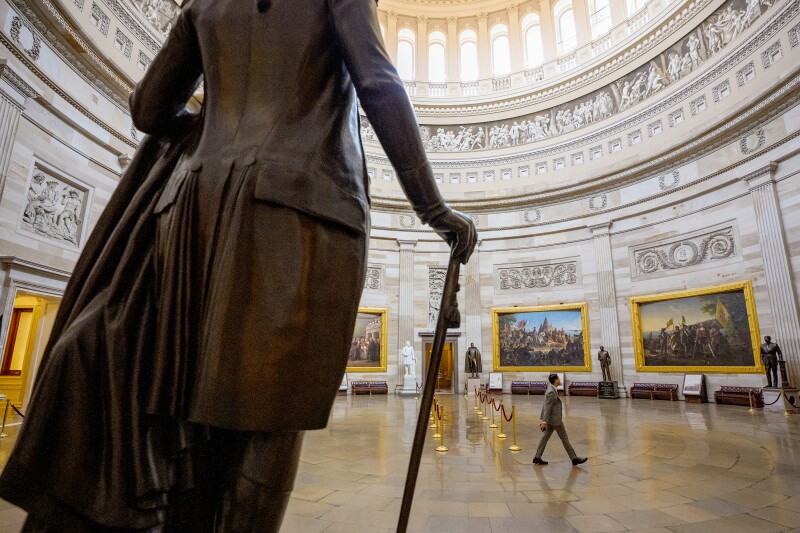Politics
U.S. Faces Looming Fiscal Crisis with Record Debt and Deficits

The U.S. Treasury Department has released its final report for the fiscal year, revealing significant financial challenges for the government. In 2025, the government spent over $7 trillion while collecting only $5.2 trillion in tax revenue. To bridge this gap, the government borrowed $1.8 trillion, which represents more than a quarter of public spending and approximately 6% of the country’s gross domestic product (GDP). Experts are increasingly using the term “unsustainable” to describe this fiscal trajectory.
As Congress grapples with a potential government shutdown, concerns about this escalating financial crisis have largely been overlooked. The Congressional Budget Office (CBO) has projected that if current laws remain unchanged, the federal debt is expected to rise sharply in the coming decades. Currently, the debt-to-GDP ratio is at a postwar high of around 100%. This figure could exceed 150% in the next few decades, with scenarios predicting it might surpass 200% if interest rates rise by just 5 basis points annually.
Trust Funds Near Insolvency
The situation is compounded by the imminent insolvency of three major federal trust funds. The Highway Trust Fund, which relies on gas taxes, is projected to run out of money by 2028. Similarly, both the Social Security retirement fund and the Medicare hospital-insurance fund are on track to be depleted by 2032. If these funds are exhausted, automatic cuts will take effect, resulting in a 46% reduction in highway spending, a 24% cut to Social Security benefits, and a 12% decrease in Medicare payments.
Congress has historically opted to waive these regulations, allowing the debt to continue growing. If this trend persists, lenders will likely begin to question the government’s ability to make full repayments, leading to increased interest rates to offset risk. Current economic pressures due to demographic changes, such as an increasing ratio of dependents to workers, alongside demands for greater investment in defense and clean energy, are expected to further strain the fiscal landscape.
Need for Immediate Action
The budget deficit has reached levels that render simple solutions ineffective. Stabilizing the debt at 100% of GDP would require reducing the deficit from $1.8 trillion to approximately $1.3 trillion. This necessitates annual cuts or tax increases totaling around $500 billion, equivalent to a 10% increase in taxes across the board. Stabilizing the debt is not sufficient; even at 100% of GDP, there would be little room to respond to economic downturns or other emergencies.
Delays in addressing these fiscal challenges exacerbate the issue. Both the White House and Congress need to acknowledge the seriousness of the situation and consider a combination of spending cuts and tax increases to confront this crisis. A mere acknowledgment of the problem would represent a significant step forward in addressing the looming fiscal emergency.
This analysis highlights the urgent need for policymakers to take decisive action before the situation escalates further. The financial stability of the United States may depend on it.
-

 Science3 weeks ago
Science3 weeks agoResearchers Challenge 200-Year-Old Physics Principle with Atomic Engines
-

 Politics1 week ago
Politics1 week agoHamas Chief Stresses Disarmament Tied to Occupation’s End
-

 Science1 week ago
Science1 week agoOhio State Study Uncovers Brain Connectivity and Function Links
-

 Top Stories1 week ago
Top Stories1 week agoFederal Agents Detain Driver in Addison; Protests Erupt Immediately
-

 Entertainment1 week ago
Entertainment1 week agoMegan Thee Stallion Exposes Alleged Online Attack by Bots
-

 Entertainment2 weeks ago
Entertainment2 weeks agoSyracuse Stage Delivers Lively Adaptation of ‘The 39 Steps’
-

 World3 weeks ago
World3 weeks agoGlobal Military Spending: Air Forces Ranked by Budget and Capability
-

 Top Stories1 week ago
Top Stories1 week agoWill Smith Powers Dodgers to World Series Tie with Key Homer
-

 Politics3 weeks ago
Politics3 weeks agoNHP Foundation Secures Land for 158 Affordable Apartments in Denver
-

 Top Stories1 week ago
Top Stories1 week agoOrioles Hire Craig Albernaz as New Manager Amid Rebuild
-

 Politics1 week ago
Politics1 week agoNFL Confirms Star-Studded Halftime Show for Super Bowl LVIII
-

 World2 weeks ago
World2 weeks agoBoeing’s Aircraft Production: Assessing Numbers and Challenges









